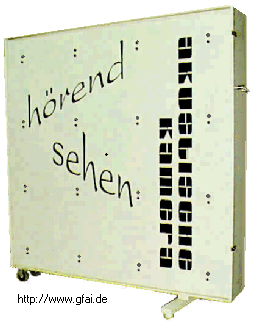January 1997
Airplane's Jet Noise Mirrors at the Ground

-
Fig.1) Jet noise reflected at the ground. For the first time we see a ground reflection of noise. Only the left jet engine is running. Acoustic interference integral with overlay of an optical image, integration interval 25 ms. To clean the photo for the journalists, some obstacles were removed from the overlay. Click on the image, to download the original AVI-file. A photo, that has gone around the world, for example see
GEO Korea.

-
Fig.2) Measuring position in 30 meter distance to the airplane. Click the image to hear the noise.
-
Fig.3): High-speed movie of the noise with 10.000 images per second, integration interval 2.5 ms per picture (overlapping 25 frames per image). Converted AVI-movie to MP4.
Airplanes produce a lot of noise. One of the main problems is the extreme loudness. In the measuring position we got amplitudes from the microphones in the range of 15 Vpp (jets in half-power position). Using Measuring microphones Gefell MK250 with a sensitivity of 50 mV/Pa this means, the ac-air pressure in a distance of 30 meters was 0.003 atmospheres or 300 Pa or 143.5 dB(C). To reduce the maximum level, we used felt-pads covering the microphones.
At the airport it was not able, to calculate the images. We went home. At GFaI I found, that 5 of 6 records were overamplified. Only one record was in range. Independent which parameters I changed, this error-free record produced only two vertical noise sources. Where is the second jet? It was frustrating. I was sure, to find two horizontal sources for the two jets. Is there any new and unknown acoustic effect within the interference reconstruction, we did not know? Or do we have an unknown software bug?
After a week of experiments with PSI-Tools I asked our partner at Lufthansa-Technik AG back, why only this single record was in range. The partner looked in his test-table and answered: "In this test the right jet was down, only the left jet was running. In all other tests both jets were running". So the vertical emission could be only the noise reflected at ground! This was one of the best days I ever had! And PSI-Tools got a new function: If a channel is overamplified, now it showed red lines at the horizonal borders of the channel.
Because of certain circumstances it was not possible to map the vector-image and the acoustic image very exactly. It was not possible to use the support of the laser positioning of the array, because it was to light to recognize the laser point. For safety reasons, we were not allowed, to come closer to the airplane.
Details about Figures 1) and 3): Noise emission of a Boing 737-400 in half power position of the left jet. The right jet was stopped. Measuring distance was 30 meters. For the first time we see a mirroring noise emission at the ground. Data: TURB4.CHL, GROS4.INI, 20 kSps, interference integral over 500 Samples = 25 msec, 16 channel reflective microphone array with mics Gefell MK250, 90cm x 90cm, felt pads on the mics to reach the sound level of 143 dB(C).

-
Fig.4) Noise of the power supply turbine. It seems, the mapping is not really exact. We could not verify the laser spot on the airplane.

-
Fig.5) Photo at the measurement position.
View to the power supply turbine in Fig.4): Data: Distance 15 m, 50 kSps, interference integral with maximum-operator over three seconds (PSI-Tools), recorded with a reflective, 16 channel microphone array 90cm x 90cm, Fig.6; data: HILF2.CHL, HILF2EXP.INI, 20kSps.

-
Fig.6) Reflective microphone-array 16 channels MK250 with central laser positioning beam. Felt-pads covered the microphones to attenuate the noise.
Jet noise is not our special field of research. To find research activities about noise reduction at airplanes in germany see this DLR-link.
Remarks
1 atm = 100000 Pa = 100 kPa = 0.1 MPa1 Pa = 1 N/m▓
0 dB = 2*10E-5 Pa Wahrnehmungsgrenze
110 dB = 20 Pa Schmerzschwelle
Mikrofonempfindlichkeit des Messmikrofons Gefell MK250:
50 mV/Pa = 50 mV m▓/N = 5 kV/atm
d.h. als Gr÷▀engleichung:
P [Pa] = V [mV] / 50 bzw.
Lp [dB] = 20 lg (u~ / u░) Schalldruckpegel in dB (MK250: u░ = 1ÁV)
Reference
[1] Lighthill, M.J.: On sound generated aerodynamically. Proc. Royal Soc., (A) Part 1: 211(1952) pp. 564-587, Part 2: 222 (1954) pp. 1-31
for the kind support to get this noise records and fotos!
File created 10:49 21.01.1997
Layout enabled for smartphones; avi-conversion to mp4, smart corrections, additional comments Oct.20, 2020; Nov.11, 2023